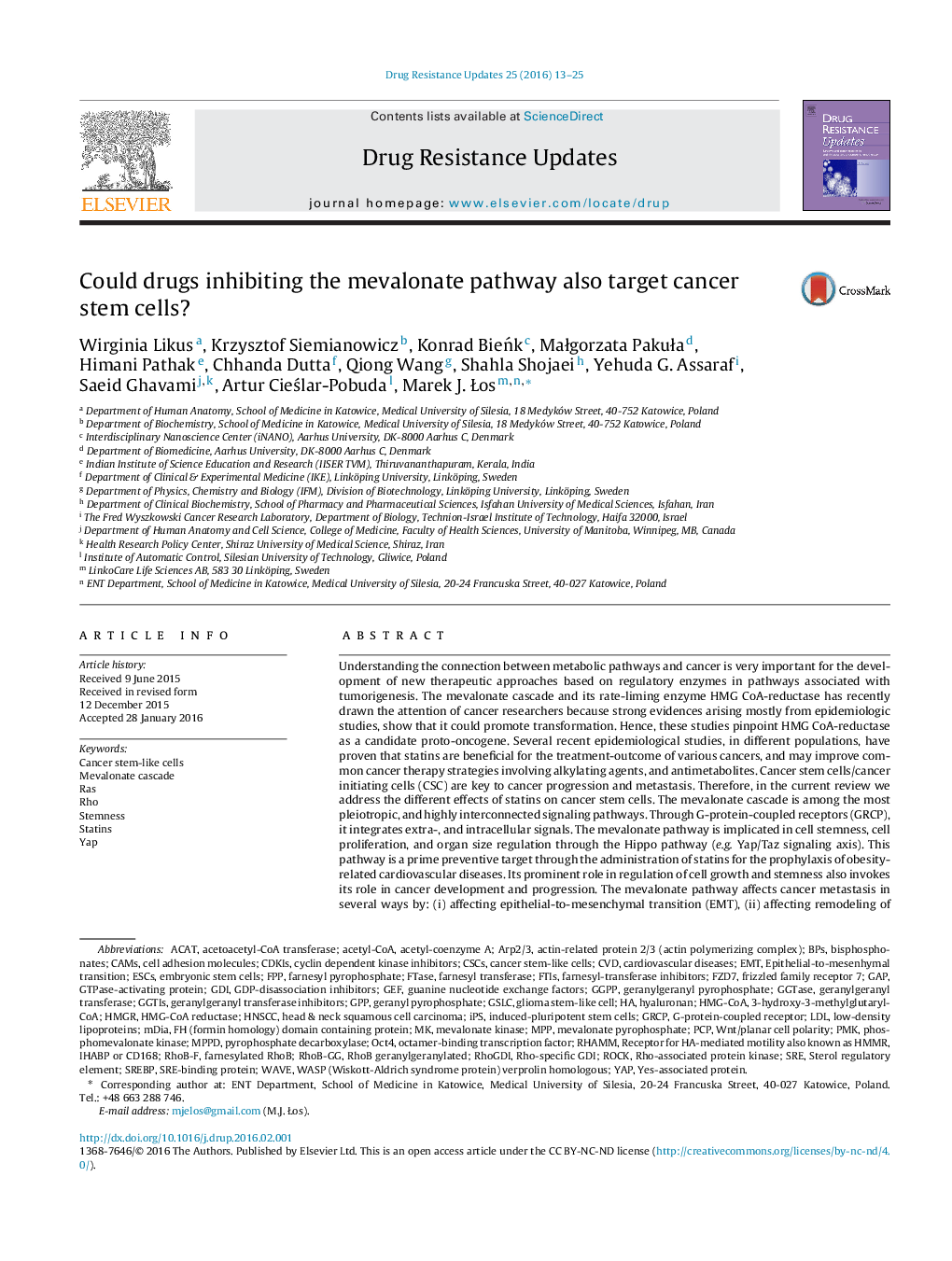| کد مقاله | کد نشریه | سال انتشار | مقاله انگلیسی | نسخه تمام متن |
|---|---|---|---|---|
| 8436713 | 1546838 | 2016 | 13 صفحه PDF | دانلود رایگان |
عنوان انگلیسی مقاله ISI
Could drugs inhibiting the mevalonate pathway also target cancer stem cells?
ترجمه فارسی عنوان
آیا داروهای مهار کننده مسیر مونولونات نیز سلول های بنیادی سرطانی را هدف قرار می دهند؟
دانلود مقاله + سفارش ترجمه
دانلود مقاله ISI انگلیسی
رایگان برای ایرانیان
کلمات کلیدی
Oct4PMKRASACATMPPDBPSFTIsGGPPmDiaInduced-pluripotent stem cellsHMG-CoASREFZD7GEFSREBPESCsHNSCCRhoGDIFTaseGGTasePCPGDIMPPFPPHMGRCSCsGPPCDKIs3-Hydroxy-3-methylglutaryl-CoA - 3-هیدروکسی 3-متیل گلوتاریل-CoAArp2/3 - Arp2 / 3CAMs - CAM هاG-protein-coupled receptor - G-پروتئین گیرندهHMG-CoA reductase - HMG-CoA ردوکتازiPS - IPSStatins - استاتین acetyl-coenzyme A - استیل کوآنزیم AAcetyl-CoA - استیل کولاYAP - ایجادStemness - بخار بودنBisphosphonates - بیس فسفوناتCardiovascular diseases - بیماری قلبی-عروقی EMT - تکنسین فوریتهای پزشکیRhamm - رامامCVD - رسوب دهی شیمیایی بخار Rho - روcancer stem-like cells - سلول های بنیادی سرطانیEmbryonic stem cells - سلولهای بنیادی جنینیGAP - شکافsterol regulatory element - عنصر نظارتی استرولGuanine nucleotide exchange factors - عوامل مبادله نوکلئوتیدی گوانینfarnesyl pyrophosphate - فارسیل پیرو فسفاتfarnesyl transferase - فارنزیل ترانسفرازPhosphomevalonate kinase - فسفوموالونات کینازLDL - لیپوپروتئین کم چگالی(کلسترول بد)low-density lipoproteins - لیپوپروتئینهای کم چگالیcyclin dependent kinase inhibitors - مهار کننده های کیناز وابسته به کینازWave - موجcell adhesion molecules - مولکول های چسبندگی سلولیHyaluronan - هیالورونانGTPase-activating protein - پروتئین فعال GTPaseyes-associated protein - پروتئین مرتبط با بلهRho-associated protein kinase - پروتئین کیناز وابسته به Rhogeranyl pyrophosphate - پیرو فسفات ژرانیلgeranylgeranyl pyrophosphate - ژرینیل گرانیل پیرو فسفاتMevalonate Kinase - کیناز Mevalonategeranylgeranyl transferase - گرانیلگرانیل ترانسفرازRock - یا راک
موضوعات مرتبط
علوم زیستی و بیوفناوری
بیوشیمی، ژنتیک و زیست شناسی مولکولی
تحقیقات سرطان
چکیده انگلیسی
Understanding the connection between metabolic pathways and cancer is very important for the development of new therapeutic approaches based on regulatory enzymes in pathways associated with tumorigenesis. The mevalonate cascade and its rate-liming enzyme HMG CoA-reductase has recently drawn the attention of cancer researchers because strong evidences arising mostly from epidemiologic studies, show that it could promote transformation. Hence, these studies pinpoint HMG CoA-reductase as a candidate proto-oncogene. Several recent epidemiological studies, in different populations, have proven that statins are beneficial for the treatment-outcome of various cancers, and may improve common cancer therapy strategies involving alkylating agents, and antimetabolites. Cancer stem cells/cancer initiating cells (CSC) are key to cancer progression and metastasis. Therefore, in the current review we address the different effects of statins on cancer stem cells. The mevalonate cascade is among the most pleiotropic, and highly interconnected signaling pathways. Through G-protein-coupled receptors (GRCP), it integrates extra-, and intracellular signals. The mevalonate pathway is implicated in cell stemness, cell proliferation, and organ size regulation through the Hippo pathway (e.g. Yap/Taz signaling axis). This pathway is a prime preventive target through the administration of statins for the prophylaxis of obesity-related cardiovascular diseases. Its prominent role in regulation of cell growth and stemness also invokes its role in cancer development and progression. The mevalonate pathway affects cancer metastasis in several ways by: (i) affecting epithelial-to-mesenchymal transition (EMT), (ii) affecting remodeling of the cytoskeleton as well as cell motility, (iii) affecting cell polarity (non-canonical Wnt/planar pathway), and (iv) modulation of mesenchymal-to-epithelial transition (MET). Herein we provide an overview of the mevalonate signaling network. We then briefly highlight diverse functions of various elements of this mevalonate pathway. We further discuss in detail the role of elements of the mevalonate cascade in stemness, carcinogenesis, cancer progression, metastasis and maintenance of cancer stem cells.
ناشر
Database: Elsevier - ScienceDirect (ساینس دایرکت)
Journal: Drug Resistance Updates - Volume 25, March 2016, Pages 13-25
Journal: Drug Resistance Updates - Volume 25, March 2016, Pages 13-25
نویسندگان
Wirginia Likus, Krzysztof Siemianowicz, Konrad BieÅk, MaÅgorzata PakuÅa, Himani Pathak, Chhanda Dutta, Qiong Wang, Shahla Shojaei, Yehuda G. Assaraf, Saeid Ghavami, Artur CieÅlar-Pobuda, Marek J. Åos,
